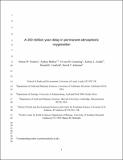Files in this item
A 200-million year delay in permanent atmospheric oxygenation
Item metadata
| dc.contributor.author | Poulton, Simon | |
| dc.contributor.author | Bekker, Andrey | |
| dc.contributor.author | Cumming, Vivien | |
| dc.contributor.author | Zerkle, Aubrey Lea | |
| dc.contributor.author | Canfield, Donald | |
| dc.contributor.author | Johnston, David | |
| dc.date.accessioned | 2021-09-28T23:38:32Z | |
| dc.date.available | 2021-09-28T23:38:32Z | |
| dc.date.issued | 2021-03-29 | |
| dc.identifier | 273038298 | |
| dc.identifier | 10cad2d9-6a60-4a5b-bb69-33204524bb6f | |
| dc.identifier | 85103318951 | |
| dc.identifier | 000634663900001 | |
| dc.identifier.citation | Poulton , S , Bekker , A , Cumming , V , Zerkle , A L , Canfield , D & Johnston , D 2021 , ' A 200-million year delay in permanent atmospheric oxygenation ' , Nature . https://doi.org/10.1038/s41586-021-03393-7 | en |
| dc.identifier.issn | 1476-4687 | |
| dc.identifier.other | ORCID: /0000-0003-2324-1619/work/91685959 | |
| dc.identifier.uri | https://hdl.handle.net/10023/24041 | |
| dc.description | S.W.P. acknowledges support from a Leverhulme Research Fellowship and a Royal Society Wolfson Research Merit Award. A.B. acknowledges support from the University of Johannesburg in the form of a Distinguished Visiting Professorship. D.T.J. acknowledges support from a NASA Exobiology award (NNX15AP58G). | en |
| dc.description.abstract | The rise of atmospheric oxygen fundamentally changed the chemistry of surficial environments and the nature of Earth’s habitability1. Early atmospheric oxygenation occurred over a protracted period of extreme climatic instability marked by multiple global glaciations2,3, with the initial rise of oxygen concentration to above 10−5 of the present atmospheric level constrained to about 2.43 billion years ago4,5. Subsequent fluctuations in atmospheric oxygen levels have, however, been reported to have occurred until about 2.32 billion years ago4, which represents the estimated timing of irreversible oxygenation of the atmosphere6,7. Here we report a high-resolution reconstruction of atmospheric and local oceanic redox conditions across the final two glaciations of the early Palaeoproterozoic era, as documented by marine sediments from the Transvaal Supergroup, South Africa. Using multiple sulfur isotope and iron–sulfur–carbon systematics, we demonstrate continued oscillations in atmospheric oxygen levels after about 2.32 billion years ago that are linked to major perturbations in ocean redox chemistry and climate. Oxygen levels thus fluctuated across the threshold of 10−5 of the present atmospheric level for about 200 million years, with permanent atmospheric oxygenation finally arriving with the Lomagundi carbon isotope excursion at about 2.22 billion years ago, some 100 million years later than currently estimated. | |
| dc.format.extent | 17 | |
| dc.format.extent | 1408941 | |
| dc.language.iso | eng | |
| dc.relation.ispartof | Nature | en |
| dc.subject | GE Environmental Sciences | en |
| dc.subject | DAS | en |
| dc.subject | SDG 13 - Climate Action | en |
| dc.subject | SDG 14 - Life Below Water | en |
| dc.subject.lcc | GE | en |
| dc.title | A 200-million year delay in permanent atmospheric oxygenation | en |
| dc.type | Journal article | en |
| dc.contributor.institution | University of St Andrews. School of Earth & Environmental Sciences | en |
| dc.contributor.institution | University of St Andrews. St Andrews Centre for Exoplanet Science | en |
| dc.contributor.institution | University of St Andrews. St Andrews Isotope Geochemistry | en |
| dc.identifier.doi | 10.1038/s41586-021-03393-7 | |
| dc.description.status | Peer reviewed | en |
| dc.date.embargoedUntil | 2021-09-29 |
This item appears in the following Collection(s)
Items in the St Andrews Research Repository are protected by copyright, with all rights reserved, unless otherwise indicated.

